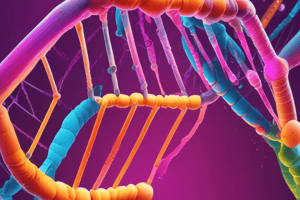Podcast
Questions and Answers
What is the name of the technique used to separate DNA fragments based on their size and charge?
What is the name of the technique used to separate DNA fragments based on their size and charge?
Electrophoresis
What is the material from which agarose gel, used in the process, is extracted?
What is the material from which agarose gel, used in the process, is extracted?
Sea weed
What type of charge should the electrode at one end of the electrophoresis plate have?
What type of charge should the electrode at one end of the electrophoresis plate have?
Positive charge (Anode)
What substance is mixed with DNA fragments before they are loaded onto the electrophoresis plate?
What substance is mixed with DNA fragments before they are loaded onto the electrophoresis plate?
What is the name of the method used to observe the separated DNA fragments under UV light?
What is the name of the method used to observe the separated DNA fragments under UV light?
Explain the role of agarose gel in the process of DNA electrophoresis.
Explain the role of agarose gel in the process of DNA electrophoresis.
What is the purpose of ethidium bromide in DNA electrophoresis?
What is the purpose of ethidium bromide in DNA electrophoresis?
Describe the movement of DNA fragments during electrophoresis in relation to the electric current and the agarose gel.
Describe the movement of DNA fragments during electrophoresis in relation to the electric current and the agarose gel.
What is the significance of observing bright orange bands under UV light in DNA electrophoresis?
What is the significance of observing bright orange bands under UV light in DNA electrophoresis?
Explain how the DNA fragments are separated based on their size in the process of electrophoresis.
Explain how the DNA fragments are separated based on their size in the process of electrophoresis.
What is the function of ethidium bromide in DNA separation using electrophoresis and agarose gel?
What is the function of ethidium bromide in DNA separation using electrophoresis and agarose gel?
Explain the process of DNA separation using electrophoresis and agarose gel.
Explain the process of DNA separation using electrophoresis and agarose gel.
How does the movement of DNA fragments occur in electrophoresis?
How does the movement of DNA fragments occur in electrophoresis?
What is the source of agarose used in agarose gel electrophoresis?
What is the source of agarose used in agarose gel electrophoresis?
Explain the importance of the positive charge electrode (anode) in DNA separation using electrophoresis and agarose gel.
Explain the importance of the positive charge electrode (anode) in DNA separation using electrophoresis and agarose gel.
What is the structure called when the blastomeres are arranged as a solid ball and take in fluid to create a cavity?
What is the structure called when the blastomeres are arranged as a solid ball and take in fluid to create a cavity?
In which stage does gastrulation occur?
In which stage does gastrulation occur?
What is the initial result of the fusion of the female egg cell and the male sperm cell in sexually reproducing organisms?
What is the initial result of the fusion of the female egg cell and the male sperm cell in sexually reproducing organisms?
What is the term for the formation of the nervous system during embryonic development?
What is the term for the formation of the nervous system during embryonic development?
What is the stage called when the mammalian blastocyst hatches before implantation into the endometrial lining of the womb?
What is the stage called when the mammalian blastocyst hatches before implantation into the endometrial lining of the womb?
Flashcards are hidden until you start studying
Study Notes
DNA Separation Technique: Electrophoresis
- Electrophoresis utilizes an electric current to separate DNA fragments based on their charge and size.
- DNA is negatively charged, so when an electric field is applied, DNA fragments migrate towards the positive electrode (anode).
- Agarose gel, derived from seaweed, serves as the medium for electrophoresis, ideal for separating nucleic acids.
- DNA samples are prepared by mixing them with ethidium bromide, which intercalates with the DNA, allowing visualization after separation.
- When electric current is passed through the agarose gel, smaller DNA fragments travel faster than larger ones, resulting in distinct separations.
- After the electrophoresis process, the gel is examined under UV light, where DNA bands appear bright orange due to the bound ethidium bromide.
- The separated DNA fragments can be identified and analyzed based on their size, represented by the orange bands on the gel.
- Results from electrophoresis provide insights into the genetic makeup and variations of DNA.
Studying That Suits You
Use AI to generate personalized quizzes and flashcards to suit your learning preferences.



